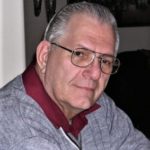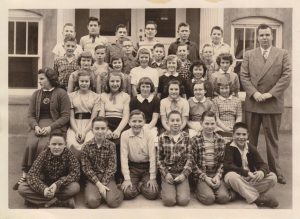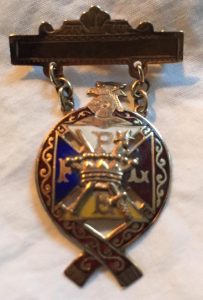A lot is being said about history today. Some want to forget it. Some want to destroy it. Some live as victims of it. Few really examine it. My wife is a history buff. I do not study it academically but do professionally. All of us exist on this planet because of it. The story can and should be viewed personally. But, if we see ourselves as victims, our perspective is skewed and we cannot see ourselves as beneficiaries of history, whether His -story, our story, or their story.
Of course by His story, I mean, the story of Jesus Christ. In my story, if I am a victim, then it is skewed and not worth telling. Telling my story, if true and as unbiased as possible, might benefit you. I pray that your story, no matter how tragic and painful for you, might become His story.
I do not mean to be poetic, cathartic, or therapeutic. This article is meant to be engaging, hopefully encouraging, and perhaps point the way for you to rewrite your story. King Solomon did this in the form of Ecclesiastes. He was able to separate life “under the sun” from life in the presence of God. I put in my bucket list to write a commentary on what I learned from studying Solomon’s story under the sun. Maybe, if God is willing, I will have enough time under the sun to do that. But back to my immediate story.
As I put my fingers to the keyboard, I am aware that many of you reading this have been affected by and exist because of the history of the Back Farm, i.e., a life that went on back on the Back farm on Bunker Creek Road, west of Adna, Washington, west of Chehalis, Washington, and west of most of the United States. Many of you began your life west of the Pacific Ocean in the Philippines. Wow! Think of that. Life on the Back farm extended clear over to you. With this perspective, let me begin.
Mr. Curtis Lars and Mrs. Agnes Marie Back were good people. The salt of the earth. Raised in a small rural setting. In this article, I use their given names to avoid confusion because I had the privilege of caring for my birth mother and her husband at the end of their lives. Curt and Agnes were good people. I mean this sincerely. My only recollection of their early life together before my story began on the Back farm were pictures hanging on the Wall-of-History at Adna High School. I remember passing under them. Looking up at them. They were king and queen of their class, handsome, and beautiful. And popular. Someone I had to look up to because everyone else did.
Curt went on to be a successful farmer and eventually Chairman of the Adna School Board, Chairman of the Board of County Commissioners of Lewis County, Dairy Products Commissioner for the State of Washington appointed by Governor Al Rossellini, and chairman of this and that. He always seemed to end up chairman of this or that. A great leader, at least for a time. But that’s his story.
My story on the Back farm began in early October 1949. I had been in foster care for most of my seven years. I would be eight in a few days. The night was dark and somewhat confusing to me. Curt and Agnes arrived to pick me up from a home on a lake east of Yelm, Washington. He was dressed in a tux. She was in a flowing gown. They were coming from a state convention of the Knights of Pythias and Pythian Sisters where he was the Supreme Chancellor of the Knights and she was the Supreme Chief of the Sisters.
We arrived on the farm early in the morning. It was still dark. We were greeted by Donska, the biggest dog I ever saw. A Great Dane. Recovering from fright because Donska turned out to be friendly, my next reaction was anger. Someone, I believe a grandmother from my biological family, sent me a box of chocolate-covered cherries. Donska enjoyed my birthday without me by eating the whole box.
My first year on the farm was to be a trial before the adoption was final. It was wonderful. I had never experienced such freedom to roam and explore. It was on the river so there was danger but what boy does not enjoy that. There was a barn with rafters to climb up into and look out over the countryside and down at the haymow and cows and chickens, and there were trees to climb. There was even an old schoolhouse that had been moved from another location to serve as a granary and shop. The bell was still in the belfry. It did not take long for me to figure out a way to climb up and ring the bell.
Life was great that first year. There was no one to fight with. Curt and Agnes were wonderful. I even learned what swearing was. I probably heard it before but learned firsthand when I swore and was told it was wrong. There were cousins, three girls, one older than me and two younger. They lived a mile away on another part of the farm. I felt odd-man-out from the beginning because they were blood relatives and had been there longer than me. They used to tease me, but it was good-natured, and they were off to dancing lessons and performing and were popular in school. But as to the farm, I had died and went to heaven, that first year.
Then the trial period came to an end and the adoption became permanent. Life began to change. Why I do not know. Looking back on one’s formative years, especially if unpleasant or even painful, it seems like an eternity. The first pain was when Curt would pull my ears. It began as teasing but soon became punishment whenever I did something wrong. I must have done something wrong quite often because, thinking about it, I can still feel the pain. It ended when my ears began to bleed. Agnes made him stop.
Then there was the episode of the runt pig. In those early years, I loved to go with Curt whenever he went on his many trips. One day it was to a pig farm. There was a little runt pig. He was so tiny and cute. The owner said, if I could catch him, I could keep him. Try as I might, covered from head to toe with you know what, he was not to be caught. Finally, I was given a hand to corner the little rascal and put him in a gunny sack. He was mine. It was my job to feed and care for him.
But runts do not always stay runts. That piglet grew and grew. Besides needing to be fed greater quantities of everything and watered, he was penned up on the other side of the barn far away from the house. It was a chore to always remember to care for him. One day when I came home from school, Curt was home from one of his trips and asked me if I fed my pig. I said yes but had not. It was strange that he kept asking me the same question over and over. Each time his face got redder and he got madder. That day they had taken the pig to slaughter.
That was the worst pain I had ever experience. Curt beat me with rolled-up hair wire. I still had the scars into my twenties. While he was beating me, I said, “But daddy, I thought you loved me?” His response was, “Love s_ _ _t, what is that? That was the beginning of my quest to understand the meaning of love.
At this point in my narrative, I want to recommend three articles regarding the Doctrine of Love in the New Testament on my website, drjerryback.com. The three are Agape: The Love of Responsibility, Affection in An Age of Disaffection, and The Two Greek Terms for Love in the New Testament.
The third article listed above is an in-depth look at the true meaning of love from a biblical perspective. At the end of the article, I give a personal testimony of my lifelong search for the true meaning of love. It is not a pretty picture because it refers to events that took place after I left the farm and while I was at home for short intervals. It was a small chapter regarding life on the Back farm and points to a tragic ending, but a wonderful outcome. For me it was because of the love I found while in the navy in the person of Jesus Christ when I received Him as my savior and His story became my story.
It seems like an eternity looking back on those brief eight years when I lived on the Back farm. The estrangement I felt grew quickly. Agnes had a temper and I soon learned not to cross her. By eight years of age, I had seen a lot of life already and developed a lot of bad behavior. While I deserved much of the discipline I received, I did not deserve the abusive way in which it was delivered. Even today, when I forget and put my elbow on the table while eating, I remember the pain of a table fork jabbed into my arm. Or when I go to cut a piece of meat on my plate, I remember the scolding for using my knife the wrong way. She had other methods that are not repeatable in a family setting. I had problems controlling my bowels.
On one occasion during the summer when it was hot, I slept outside. The kitchen window was open, and Curt and Agnes were drunk and in a terrible argument. Agnes was angry with me because I had forgotten to take out the garbage. It was the only time I recall Curt opposing her disciplinary methods. As they screamed at each other, he told her to tone down or I would hear her. Her angry response as she shouted out the window was "He can go to hell."
Curt’s methods of discipline became more and more violent and more and more capricious. It usually had to do with some failure on my part to do what I was expected to do. On one occasion, I was about twelve or thirteen years of age, he was teaching 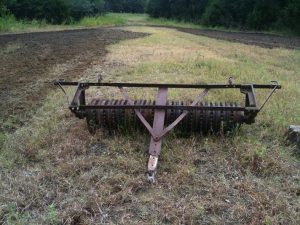 me to cultipack in the large field between the farmhouse and Bunker Creek road. The purpose was to compact the soil over the newly planted pea seed. At first, he had me drive an International Harvester Model H tractor. The kind that has two wheels close together in front.
me to cultipack in the large field between the farmhouse and Bunker Creek road. The purpose was to compact the soil over the newly planted pea seed. At first, he had me drive an International Harvester Model H tractor. The kind that has two wheels close together in front.
For Curt, being a stickler regarding the looks of the field for those driving by, the rows had to be straight. At the end of the rows, the turns had to be tight. Every time I came to the end of the row, I was to use the suicide knob on the steering wheel and turn quickly. Every time I did, the wheels jerked and turned sideways with the tractor moving straight ahead instead of turning, plowing ruts in the field. Curt stood on the drawbar behind me and slapped me back and forth across the head, yelling and cursing me. This went on for more than an hour.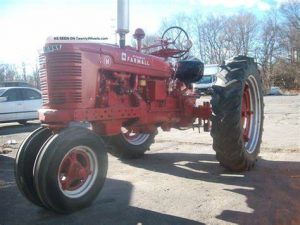
Finally, Curt had me stop the tractor. He unhitched it and drove off without a word leaving me sitting on the cutlipacker wondering what was next. Soon he returned with a model A with front wheels that were wide apart. It was impossible to turn the wheels so that they plowed, and I made perfect turns every time from then on.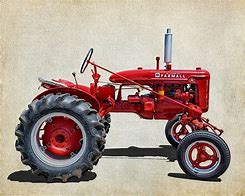
On another occasion, I was about fourteen, baling straw behind where the Smiths lived east of the farmhouse. I do not remember what I did wrong, but Curt got mad and beat me with a pitchfork on the back of my legs as I ran from him. The injuries were serious enough that I had difficulty walking. That evening, as I was helping Uncle Nelly milk cows, he noticed me limping and asked what was wrong. I raised my pant legs and showed him my legs. A few minutes later, Curt came into the milking parlor and, without a word, Nelly jumped on him knocking him down. That was the only time I saw Nelly raise a fist in anger against him. It was the only time anyone came to my defense.
In the summer of 1956, when I was fifteen, I finally had enough and decided to run away. I packed a small suitcase, and hiked down along the river and over Ceres Hill to highway 6. From there I hitchhiked to Astoria, Oregon, and on to Rainer, Oregon. While walking down the highway at Rainer, I was picked up by an Oregon State trooper. He asked me where I was going, and when I did not provide ID, contacted the police in Chehalis. While we waited for a reply, we sat in his patrol car and I told my story. He said if I had been truthful from the start, he would have let me go but he already had heard from Chehalis. His instructions were to transport me to the middle of the Bridge crossing the Columbia river where I was to be transferred to a Washington State Trooper who would then take me to the Lewis County line where I was to be taken into custody by the county police.
The county official who arrived at the county line was none other than Sheriff Porky Amondson, a friend of Curt Back, who was chairman of the Board of County Commissioners. The state patrol car was parked alongside the highway with me on the right side of the back seat. When Sheriff Amondson opened the door and ordered me out, there was a sharp drop-off. He did not warn me or assist me. Because it was dark, I fell into a ditch. It was apparent that I was to be treated as a criminal. I later learned that Sheriff Amondson tried to convince Curt that I had stolen money and Agnes’ jewelry, but Curt did not believe him.
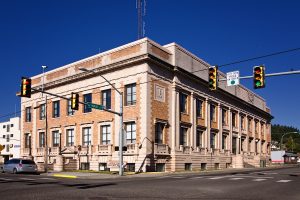
I was booked into solitary confinement in the country jail in Chehalis. The next morning, out of desperation, I asked the jailers to contact the family's Lutheran pastor. He came right away. When Curt arrived, the pastor scolded him and told him to take me home. Thus, ended my first incarceration in that solitary cell.
In the fall of that year, I again found myself on the bad side of Curt. It had something to do with my work. Curt threatened to not let me go to school. At the time he was chairman of the school board and I had no doubt he could do it. That night I drove to Chehalis to find the Adna High School principal to tell him of the threat. Curt came looking for me and found me at the principal’s apartment. He took me to the county jail and left me in the same solitary confinement cell. Three days later I agreed to behave, and he took me back to the farm.
By the fall of my junior year, Curt did not work on the farm and was heavily involved in other businesses. We seldom saw him. He would come home in the wee hours of the morning, sleep until midday, and was off again. One morning, I finished milking cows and returned home in time to feed the beef cows before school. It was cold. I was wet from milking. I stopped the car and left it running to warm up and fell asleep. Curt came out of the house, found me, and began screaming at me. He followed me into the barn all the while cursing me and telling me how worthless I was. I turned and shouted back about his not ever being around. I turned to finish what I was doing. Curt picked up a barn shovel and hit me over the head, knocking me down. He then picked up a pitchfork and stabbed me with it. Fortunately, I had on a heavy jacket so was not injured but was still dazed from the blow to the head. I got up and swung at him hitting him in the face. He took off. I managed to stagger out of the barn but collapsed. A little while later, a hired hand found me and help me up. I went to the basement of the farmhouse and collapsed on an old couch.
I laid there all day bleeding from my head wound. Agnes never came down to inquire what had happened or how I was. Toward evening, Curt returned from town, got me up, and took me back to my solitary confinement cell in the country jail. When the jailers were booking me, they saw the injury to my head and took me to the hospital where I was treated and returned to my cell.
This time, I refused to be discharged until I could meet with the juvenile judge of Lewis County. Somehow, I had the idea he might be the only one in the county not in Curt Back’s back pocket. It took five days for the meeting to be arranged. All the while I was in solitary confinement. Curt, Agnes, and I met in the Judge’s chambers. I was alone without representation. The prosecuting attorney of Lewis County came to represent Curt and Agnes.
The meeting was short. When the prosecuting attorney heard the first part, he said, “Curt, I can’t help you.” and left. When the judge heard the full story and saw the wound to my head, he immediately declared me a ward of the court. I was free to go stay with anyone who would take me in.
There was a family by the name of Barrett that lived across the river. They had two boys, one was my age and the other younger. Anytime I could, I spent time with them and came to appreciate how well their family lived together. They had moved to a railroad community near Rainier, Washington. I asked if I could live with them to finish my junior year of high school at Rainier High School. They agreed to take me in. Curt was responsible to pay for my upkeep.
During the summer of 1959, I worked for the Department of Natural Resources in Chehalis. It was a fantastic job. There were several of us who formed a fire crew to fight many different types of fires from forest fires to the smoldering perennial fire in the sawdust pile at the Winlock mill.
 Because of my background working on the farm and my dependability, I was elevated to working with an engineer traversing fire roads and locating old survey monuments. I would pull and hold the surveying chain while he recorded the locations to update maps. Late in the summer, I was chosen to be the grease monkey for a road crew clearing and grading fire roads in the Ryderwood forest area west of Winlock managed by the department. I would drive the pickup behind the road grader and cat. When they stopped, I would lube and fuel the equipment. The rest of the time I was able to explore or napped as they moved slowly along. Periodically I would catch up and do my job.
Because of my background working on the farm and my dependability, I was elevated to working with an engineer traversing fire roads and locating old survey monuments. I would pull and hold the surveying chain while he recorded the locations to update maps. Late in the summer, I was chosen to be the grease monkey for a road crew clearing and grading fire roads in the Ryderwood forest area west of Winlock managed by the department. I would drive the pickup behind the road grader and cat. When they stopped, I would lube and fuel the equipment. The rest of the time I was able to explore or napped as they moved slowly along. Periodically I would catch up and do my job.
The cooks who prepared the meals for those of us who lived in the bunkhouse in Chehalis quit before the season was over. The question was who would do the cooking? I stepped forward. I had no experience but thought it would be fun. Thus, began my career in quantity cooking. It was the time of year that the wild berries were abundant out where the crew worked repairing fire roads. I stayed in town and cooked. They brought me buckets of wild berries and I set about to cook pies for the first time in my life. Who could not follow a recipe? Because there were about a dozen mouths to feed, there needed to be a lot of pies, so I multiplied the recipe for the crust. The only problem, the recipe was for a quantity already. My, did we have pies. The crew loved them and kept the berries coming.
When school started, I did not want to return to Adna High School but chose to end my high school career at W. F. West High School in Chehalis. One of the crewmen, a married man, and his wife, took me in and I lived with them through the winter. Just before Christmas, a social worker contacted me and told me she could put me in touch with my biological mother, which she did. My mother invited me to visit her and her husband for Christmas. At the time she lived in Peoria, Illinois. She paid for my train ticket and I went east, meeting her for the first time since I was two years old.
She offered to have me come to live with her and offered to pay for my college education. After being there and watching how she lived and got along with the family in Peoria, I turned down the invitation and returned to Chehalis. I was on my own. I was a Back come what may and would always be a Back.
Upon my return to Chehalis, contact was made with the Backs. I do not recall if I initiated it or if they did. I returned to the Back farm with the assurance that I could finish and graduate from W. F. West High School in Chehalis.
During the spring, I commuted to Chehalis. I saw little of Curt. I think the feeling was mutual. Upon graduation, Agnes attended but Curt did not. At seventeen, my last and final attempt at running away was graduating on Friday night and being inducted into the navy Monday morning. Another chapter of my story continues at the end of the article, The Two Greek Terms for Love in the New Testament. (see)
The story of life on the Back farm does not end there. There is an additional part of the story. This is about a boy adopted at birth when I was eleven years old. I chose his name, Curtis Lars Back. We called him Little Curt. I could not understand then why they wanted to try a second time when I had turned out so bad.
Little Curt was treated totally differently. He was not required to work as I had been. When he got into trouble, they defended him or made excuses for him. Because of the difference in age, he was often left in my care. But when I attempted to discipline him, Curt and Agnes would come to his defense.
My working and going to school left little time for us to bond. There were no major conflicts that I recall. Eventually, he went his way and I went mine. Of course, I was on the farm only a few of those years so what went on in my absence is his story. I know little about it. I just know that he was a lovable kid that seemed to follow the wrong crowd and get into more and more trouble.
Following Agnes’ death in 1966 and Curt’s death in 1972, Little Curt found ways to get into trouble with the law. He spent some time in the county jail for one of his escapades. Funny how things turn out. That was the jail where I spend three incarcerations without breaking the law. Another time was spent in a juvenile jail near Shelton, I believe. Finally, he was incarcerated for two years at the state penitentiary in Monroe, Washington.
He was not a mean kid. I loved him dearly and never could understand how he could get into so much trouble with the law. The only answer had to be his gullibility and those who used that to his detriment.
On one occasion while Curt was still alive, Little Curt stole items from home and ran away to Spokane, Washington. He was arrested and Curt went to get him, picking up the things he had stolen and hocked along the way. My wife and I attend the court hearing. We stood up for him and asked the judge not to send him to juvenile but to let us have custody of him. We lived in Burns, Oregon. I graduated from seminary and it was my first pastorate. Surely, he could not get into trouble in Burns.
He was such a likable kid, the Church, not knowing why he was there, could not understand why we were so strict with him. It caused some problems for me in my ministry. Eventually, Curt came to his defense and had the court release him back into his custody and Little Curt returned to the Back farm.
When he was in prison in Monroe, my wife and I visited him. Upon his release, we allowed him to come and live with us. We were starting a new church in Bellingham, Washington. We set the house rules and he agreed to abide by them. It was not long before he was defiant about those rules and, when I asked him to leave, he refused. I had to physically throw him out. The rest is his story.
We saw him and his wife and children when they visited from the Philippines when we lived in Issaquah. He showed up alone at our twenty-fifth wedding anniversary when I was pastoring a church in Yakima. The last I heard about him, his daughter, who lives in California, informed me he had died. I believe the date was December 2009.
My wife and I witnessed to him after Agnes died and he prayed to receive Christ as his savior. Sometime later, both Curt and Little Curt went forward to announce to my home church, Mountain View Baptist in Centralia, Washington, that they had received Christ as their savior. What a shock to the congregation. Little Curt was there with Curt and his second wife and her children. Two Curts. One was chairman of the Board of County Commissioners. Even now it is hard to reflect and write this without crying tears of joy mingled with sorrow.
As I said, I loved Little Curt dearly but was not able to protect him from history. I learned to love Curt also and was there when he was killed in a tragic car accident. While I could not help them here on earth in history, I believe I will see them in heaven along with Agnes because of His story. I learned after her death that she had attended the little church in Adna where they used to take me to Sunday School and drop me off.
Now how about Your story? How will the last chapter be written about you? Will it end here under the sun and continue in heaven because of His story?
